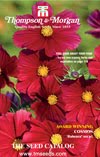In terms of grower satisfaction, it’s hard to beat herbs. If you have limited time and space, herbs give you more for less than anything else you can grow. Just one or two leaves of the right herb can completely transform a salad, pasta dish or stew. Best of all, they are easy to grow and immune to most pests.
The compact growth of most herbs makes them ideal for containers, too. A few nursery pots, 18-24” across the top, will provide a happy home for your herbs. In a colder climate, you can bring the pots indoors to a sunny spot.
Choose as many herbs as you will actually use and have room for. Make sure you sort them into two groups, annuals and perennials. Common annuals include basil, dill and parsley. Common perennials include chives, mint, oregano, rosemary, sage, sorrel and thyme. Whether you grow herbs in beds or in pots, keep your perennials separate from your annuals so they can continue to grow year after year without being disturbed.
Most herbs will grow well from seed, but transplants are just as easy to grow. With transplants, make sure the soil or growing medium you’re putting the plants into is well-watered (moist but not soggy) in advance. Drainage is important – few plants like wet feet – so augment your soil with perlite, vermiculite or compost.
If you start herbs from seed, wait until the seedlings have their first true leaves (leaves that resemble those of an adult plant), then thin them so they stand several inches apart. Do this by snipping off the unwanted plants at ground level with scissors – don’t pull them out, which can injure the roots of the surviving plants.
Monday, July 19, 2010
Subscribe to:
Posts (Atom)





